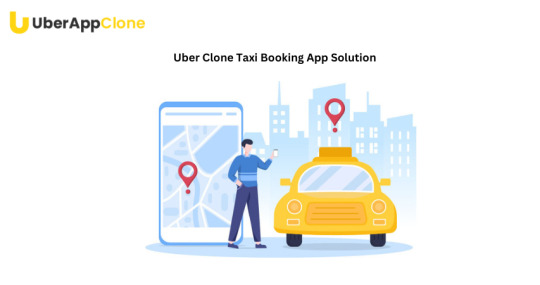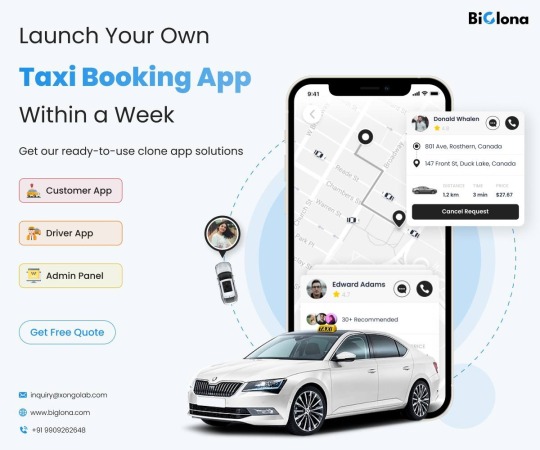#taxibookingapps
Explore tagged Tumblr posts
Text
The transportation market of Tanzania has transformed due to online taxi booking apps for convenient, safer, and cost-efficient rides. Read to know more.

1 note
·
View note
Text
How to Build a Scalable Taxi Booking App for Your Business
Creating a scalable taxi booking app can significantly enhance your business operations and expand your reach in the competitive market. This guide covers essential steps and considerations for developing a scalable taxi booking app, ensuring it meets your business needs and scales effectively with growing demand.
The taxi booking app market has witnessed exponential growth, driven by the increasing demand for convenient transportation solutions. With technological advancements, customers expect real-time tracking, seamless booking experiences, and reliable services. A well-designed, scalable taxi booking app can help businesses capture this growing market and improve customer satisfaction.
Scalability is crucial for taxi booking apps to handle increasing user demands without compromising performance. A scalable app can accommodate more users, process higher transaction volumes, and integrate new features effortlessly, ensuring a smooth user experience as your business grows.
Understanding the Basics
Key Features of a Taxi Booking App
A successful taxi booking app typically includes the following features:
User Registration and Profile Management: Allow users to create and manage their profiles.
Real-Time Booking and Tracking: Enable users to book rides and track their taxi in real-time.
Payment Integration: Offer various payment options for convenience.
Driver and Vehicle Management: Manage driver profiles and vehicle details.
Rating and Reviews: Allow users to rate and review their rides.
Types of Taxi Booking Apps
Taxi booking apps can be categorized into different types based on their functionalities and target audiences:
On-Demand Taxi Apps: Provide immediate taxi services.
Pre-Scheduled Taxi Apps: Allow users to book taxis for a later time.
Ride-sharing apps: Facilitate carpooling and ride-sharing among users.
Current Trends and Technologies
Keeping up with trends and technologies is essential for developing a competitive taxi booking app:
AI and Machine Learning: Enhance route optimization and predictive analytics.
Blockchain: Improve security and transparency in transactions.
IoT: Enable real-time vehicle tracking and diagnostics.
Planning Your App
Defining Your Target Audience
Identifying your target audience is crucial for tailoring your app's features and design. Consider factors such as:
Geographic Location: Focus on areas with high demand for taxi services.
Demographics: Understand the preferences and needs of your potential users.
Market Research and Competitor Analysis
Conduct thorough market research and analyze competitors to identify gaps and opportunities. Look at:
Existing Apps: Evaluate their features, strengths, and weaknesses.
User Feedback: Gather insights from user reviews and ratings.
Identifying Core Features and Functionalities
Determine the core features that will differentiate your app from competitors. Essential functionalities might include:
Seamless Booking Process: Ensure an easy and quick booking experience.
Advanced Search Filters: Allow users to customize their search preferences.
In-App Chat: Facilitate communication between drivers and passengers.
Designing the User Experience (UX)
Creating a User-Friendly Interface
A user-friendly interface is key to ensuring a positive experience. Focus on:
Simplicity: Use a clean and intuitive design.
Consistency: Maintain consistent visual elements and navigation.
Importance of Intuitive Navigation
Intuitive navigation helps users find what they need quickly and easily. Implement:
Clear Menus and Buttons: Ensure that navigation elements are easily accessible.
Guided Tutorials: Provide onboarding guides for new users.
Designing for Multiple Platforms (iOS, Android, Web)
Develop your app for various platforms to reach a wider audience. Ensure:
Cross-Platform Compatibility: Use responsive design principles.
Consistent Experience: Maintain a uniform look and feel across platforms.
Choosing the Right Technology Stack
Front-End Technologies
The front end of your app is crucial for user interaction. Consider technologies such as:
React Native: For cross-platform mobile app development.
Flutter: For building natively compiled applications.
Back-End Technologies
The back end handles data processing and storage. Recommended technologies include:
Node.js: For scalable and efficient server-side operations.
Python with Django: For robust and secure back-end development.
Database and Server Solutions
Choose scalable database and server solutions to handle growing data and traffic:
Cloud Databases: Amazon RDS or Google Cloud SQL for flexibility.
Server Solutions: AWS or Google Cloud for scalable infrastructure.
Integration with Maps and Payment Gateways
Integrate essential services to enhance app functionality:
Maps Integration: Use Google Maps API or Mapbox for accurate location tracking.
Payment Gateways: Implement Stripe or PayPal for secure transactions.
Developing the App
Architecture for Scalability
Design your app architecture with scalability in mind:
Microservices Architecture: Break down the app into smaller, manageable services.
Load Balancing: Distribute traffic evenly across servers.
API Development and Integration
Develop and integrate APIs for smooth functionality:
RESTful APIs: For communication between the front end and back end.
Third-Party APIs: Integrate external services like maps and payment gateways.
Real-Time Tracking and Notifications
Implement real-time features to enhance user experience:
Real-Time Tracking: Use WebSockets or Firebase for live location updates.
Push Notifications: Notify users about ride status and promotions.
User Authentication and Security
Ensure robust security measures:
Secure Authentication: Use OAuth or JWT for user authentication.
Data Encryption: Protect sensitive data with encryption protocols.
Ensuring Performance and Scalability
Load Balancing and Caching Strategies
Implement strategies to manage high traffic:
Load Balancing: Use load balancers to distribute traffic across servers.
Caching: Use caching mechanisms like Redis to improve performance.
Optimizing Database Performance
Enhance database performance with:
Indexing: Improve query speed with proper indexing.
Database Sharding: Distribute data across multiple databases.
Handling High Traffic and Peak Times
Prepare for traffic spikes by:
Auto-Scaling: Automatically scale resources based on demand.
Monitoring Tools: Use tools like New Relic or Datadog to monitor performance.
Testing and Quality Assurance
Types of Testing
Ensure thorough testing of your app:
Unit Testing: Test individual components for functionality.
Integration Testing: Verify interactions between components.
System Testing: Ensure the app works as a whole.
User Acceptance Testing: Validate the app with real users.
Automated vs. Manual Testing
Balance automated and manual testing:
Automated Testing: Use tools like Selenium for repetitive tests.
Manual Testing: Conduct manual tests for usability and edge cases.
Ensuring Cross-Platform Compatibility
Test your app across different devices and platforms to ensure:
Consistent Performance: Verify that the app performs well on various devices.
User Experience: Ensure a uniform experience across platforms.
Launching Your App
Pre-Launch Checklist
Prepare for a successful launch with a checklist:
Final Testing: Conduct thorough testing to fix any issues.
Marketing Plan: Develop a strategy for promoting your app.
Marketing and Promotion Strategies
Promote your app to reach your target audience:
Social Media: Use platforms like Facebook and Twitter for promotion.
App Store Optimization (ASO): Optimize your app’s listing for visibility.
Gathering and Analyzing User Feedback
Collect and analyze feedback to improve your app:
Surveys and Reviews: Use surveys and reviews to gather user insights.
Analytics Tools: Implement tools like Google Analytics to track usage and performance.
Post-Launch Maintenance and Support
Monitoring and Analytics
Monitor app performance and user behavior:
Performance Metrics: Track metrics like load times and error rates.
User Engagement: Analyze user engagement to identify areas for improvement.
Bug Fixes and Updates
Address issues promptly and release updates:
Bug Fixes: Resolve bugs and technical issues quickly.
Feature Updates: Regularly update your app with new features and improvements.
User Support and Engagement
Provide ongoing support and engage with users:
Customer Support: Offer support through chat, email, or phone.
User Engagement: Keep users engaged with promotions and updates.
Scaling Your App
Strategies for Scaling Infrastructure
Expand your infrastructure to handle growth:
Cloud Services: Use cloud services for flexible scaling.
Database Scaling: Implement horizontal scaling for databases.
Expanding Features and Functionalities
Add new features to meet evolving user needs:
Feature Upgrades: Introduce new features based on user feedback.
Integration with New Services: Incorporate additional services and APIs.
Geographic and Market Expansion
Expand your app’s reach to new markets:
Geographic Expansion: Launch in new cities or countries.
Market Diversification: Explore new user segments or business models.
Final Words
Building a scalable taxi booking app involves careful planning, design, and development. Focus on user experience, technology choices, and scalability to ensure your app meets business needs and adapts to growth.
Stay ahead of trends:
AI Integration: Enhance services with artificial intelligence.
Sustainability: Explore eco-friendly transportation options.
Partner with a leading taxi booking app development company to leverage their expertise and resources. A well-chosen development partner can help you create a robust, scalable app that drives business success.
FAQs - Taxi Booking App Development
1. What is a taxi booking app development company?
A top taxi app development company specializes in creating and maintaining software solutions for booking and managing taxi services. They offer expertise in designing scalable and user-friendly apps that handle various aspects of taxi operations.
2. Why is scalability important in a taxi booking app?
Scalability ensures that your app can handle increasing user traffic and data without performance issues. It allows your app to grow alongside your business, accommodating more users and additional features as needed.
3. How can I choose the right taxi booking app development company?
Look for a company with experience in building scalable apps, a strong portfolio, and positive client reviews. Consider their expertise in relevant technologies and their ability to provide ongoing support and updates.
4. What features should I include in my taxi booking app?
Essential features include real-time booking and tracking, payment integration, driver and vehicle management, user registration, and rating systems. Additional features may include advanced search filters, in-app chat, and promotional offers.
5. How can I ensure my taxi booking app performs well under high traffic?
Implement load balancing and caching strategies, optimize database performance, and use auto-scaling solutions to manage high traffic. Regular monitoring and performance testing will help identify and address any issues promptly.
#mobile app development#app development company#app developers#app development#mobile app company#mobile app developers#app development services#taxi booking app development#taxibookingapps
0 notes
Text
A Guide to Streamlining Your Taxi Business with a Mobile App

Efficiency is a key term widely used in the business world. Learn how to gain efficiency by streamlining your business processes and finally start making more money.
15 notes
·
View notes
Link

An Uber clone taxi booking app solution is a software package with latest features and technologies of the Uber taxi booking platform. It enables entrepreneurs and businesses to launch their own on-demand taxi service similar to Uber.
11 notes
·
View notes
Link
An Uber clone taxi booking app solution is a software package that replicates the features and functionalities of the popular ride-hailing platform Uber.

10 notes
·
View notes
Text
Understanding the potential and immense capabilities of the ionic framework, companies are providing Ionic App development Services.
1 note
·
View note
Text
🌟 Prepare Your Business for 2025 with the Right Backend Language! 🌟
As technology evolves, so does the need for effective backend languages in app development. Our latest blog explores the Top 5 On-Demand Backend Languages that will set you up for success in the coming years!
🔍 Discover:
The significance of backend languages in on-demand apps
Detailed insights into PHP, JavaScript, Python, Rust, and Ruby
How to choose the right language for your project
Stay ahead of the curve and learn how these languages can elevate your business! Read the full blog here: https://www.uplogictech.com/blog/top-5-on-demand-backend-languages-for-success-in-2025/
#TechInnovation#BackendLanguages#UplogicTechnologies#Technology#BackendDevelopment#AppDevelopment#USA#UK#europe#australia#southafrica#UAE#unitedstates#ondemandappdevelopment#ondemandapp#UberClone#ondemandsoftware#TaxiBookingApp#CloneApp#DigitalTransformation#UserExperience#mobileappdevelopmentcompany
0 notes
Text

Ready to take your taxi business online with an app? We've got you covered! Our pre-built solution is packed with features and ready to customize with your brand.
Save time and money with our white-lable solution. : https://bit.ly/3TOeG7Y
0 notes
Text
5 Tips for Choosing the Best Taxi Booking App in India
You can't have successful ridesharing with an outstanding app. Traditional ride-hailing services are being replaced by more sophisticated ones. Online booking services are offered through the best taxi app development providers. You can gain a competitive advantage by providing reasons to use taxi booking services. With the proper procedures and information, you can employ the company using an appropriate taxi application.
To hire the best agency, Follow these 5 steps. When you select the proper development agency, you can expect a pleasant experience. Consider business variables for the next level of success. The Taxi Booking Application Company has the best features to provide the desired results to customers. Booking the correct taxi app development requires thorough market analysis.

How do I Choose the Best Taxi Booking Application Development Company?
Let's look at some factors to consider while hiring a taxi Booking app service Company. It gives results that meet the needs of clients who want to travel by automobile or other vehicle.
1. Choose the Vehicle Type
You can select the appropriate car using an online Taxi Booking application. The hiring of the best agency will benefit the people. A list of automobiles is available in the web application to assist clients. When you hire the Company, you can ask about the vehicle types they have available. Different passengers can sit at them to achieve the desired outcome. With the correct hiring, you may have a van that meets the expectations of the customers.
You must consider hiring the greatest agency development. Different vehicles carry varying numbers of passengers. The gathering of knowledge about it is critical to making the correct decision and achieving the intended outcomes. It is possible to ride in the appropriate vehicle by booking it online using an application.
2. Live GPS Tracking With the App
You can find the top taxi developing application Company by using the live tracking app. It is a vital feature for having the proper riding experience. Customers can book taxis based on their needs and requirements. You can benefit from real GPS tracking using the application. The project can be completed easily and simply. You can learn about it and get the finest riding experience possible.
The option is developed based on people's abilities and intelligence. The process is simple for clients. Ensure that the agency offers the greatest services to customers while looking for an online taxi Booking application development Company. Meeting the needs does not require any more effort or time. The collection of information is critical for people.
3. Payment Choices are Provided by the Top Taxi Development Company
You can enquire about the payment choices accessible with the top taxi application development agency. You can choose a safe and secure method to achieve the greatest outcomes. People can gain a variety of benefits from it. Payment is easily made online using the Taxi Booking Application Development. There are several techniques available, and you should choose the best one with intelligence.
A review of the possibilities will allow you to select the best Taxi Booking Development Company. People will be able to book taxis more easily and simply. A variety of settings is provided to ensure the greatest experience.
4. Confirm and Cancel Ride Options in the Application
The best development agencies offer a cancel and confirm rising choice. The greatest application for booking a Taxi. It is the best benefit offered to the public. If a person long-presses on the option, he will receive the desired results. The unique features of online software allow you to meet your riding expectations. A glance at them is vital for getting the desired outcomes while booking a taxi and using the program.
Not all businesses offer a choice to the individual. Checking the option with the agency is advantageous to folks.
5. The Taxi Application Includes Choices for Pick-up and Drop-off
You may view the pickup and drop-off options at the online Taxi Booking App Development. These are the fundamentals that you should verify to get the greatest experience. People should be given accurate and factual information. The collection of details is required to get the desired results. The hiring of a development agency is conceivable for individuals.
The drivers understand the demands and requirements of the passengers. The selections are set based on abilities and excellence.
Conclusion
So, these are the five steps you should take to pick the top Taxi Booking Application Development Company. Riding in the vehicle is feasible through online booking. There are numerous possibilities open to you, which you can take advantage of by using your abilities and intelligence. You can obtain all the necessary and accurate information to have the desired experience.
In conclusion, a taxi booking app is a game changer for moving around town fast and efficiently. By selecting the proper app with the features that are most important to you, you may have a stress-free and seamless commuting experience. So, why wait? Download a Taxi booking app today and discover the ease for yourself.
#swayaminfotech#swayam#mobileappdevelopment#appdevelopment#technology#mobileapplicationdevelopment#buildyourteam#taxibookingapp#taxibookingappdevelopmentcompany#taxibooking#taxibookingservices
0 notes
Text






Looking to revolutionize the taxi booking industry? 🚖 Our white label solution will help you create a powerful Uber Clone app effortlessly! 💼
Get Now: https://migrateshop.com/uber-clone/
#uberclone#ubercloneapp#uberclonescript#taxibookingapp#taxibookingappsolution#ondemand#ridesharing#business#startup
0 notes
Text
Ola clone app development is essential for creating a competitive ride-hailing platform. Key features include real-time tracking, ride scheduling, secure payments, and an intuitive interface for users and drivers. Discover how to build a successful app with these features. Visit our website for more insights!
#olacloneapp#olaclonescript#olaclone#olaappclone#applikecloneola#applikeola#olacloneappscript#taxibookingapp#taxibookingsoftware#olacloneappdevelopment#olalikeapps#olataxiapp
0 notes
Text
Integrate a taxi pooling feature in your Uber Clone App and turn strangers into friends. Read the blog to know more.
#ubercloneapp#taxibookingapp#uberclonescript#ride-sharingapp#uberclone#taxipooling#transformrides#adventureawaits#ridesharing
1 note
·
View note
Text

How much does it cost to develop an app like Uber
Developing an app like Uber involves various factors, including user interface design, GPS integration, payment gateways, and backend development. The cost depends on the complexity of features like real-time tracking, driver-partner interface, and customer support. Creating a robust ride-sharing app requires expertise in handling large user bases and seamless functionality. For premium app development services, USM Business Systems is the best mobile app development company, offering tailored solutions to meet your business needs.
#UberAppCost#AppDevelopmentCost#UberCloneApp#RideSharingApp#TaxiAppDevelopment#AppLikeUber#MobileAppCost#RideSharingTech#UberCloneDevelopment#TaxiBookingApp
0 notes
Link
This is a blog post that explains more in detail about the top features that are new and latest in the 2023 version of the Uber Clone app. Today, Uber clone app is regarded as the world’s foremost on demand taxi booking platform.
9 notes
·
View notes
Text
Build your own on-demand transportation solution with #SpotnRides Uber Clone app development. Customizable, scalable, and packed with powerful features.
For more details visit:https://www.spotnrides.com/

#uberclone#ubercloneapp#taxibookingapp#taxibookingsoftware#uberclonescript#ubercloneappscript#AppDevelopment#ondemandapps#customwebapp#iosappdevelopment#androidappdevelopment#StartupIdeas#WebAppDevelopment#androidappdevelopmentcompany#business#startup#mobileappdevelopmentcompany#ondemandappdevelopment#businessowner
0 notes
Link

10 notes
·
View notes